《诊断学》课程考试试题(含参考答案)
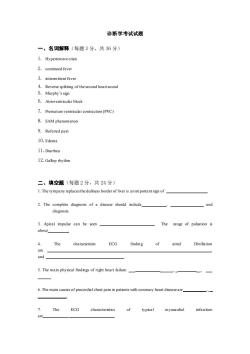
诊断学考试试题 一、名词解释(每题3分,共36分) 1.Hypertensivecrisis 2.continued fever 3.inttermitent fever 4.Reverse splitting of the second heart sound 5.Murphy's sign 6.Atrioventricular block 7.Premature ventricular contraction(PVC) 8.SAM phenomenon 9.Referred pain 10.Edema 11.Diarhea 12.Gallop rhythm 二、填空题(每题2分,共24分) 1.The tympany replacesthe dullness border of liver is an imporantsign of 2.The complete diagnosis of a disease should include an diagnosis. 3.Apical impulse can be secn The range of pulsation is about_ 4.The characteristic ECG finding of atrial fibrillation are and】 5.The main physical findings of right heart failure: 6.The main causes of precordialchest pain in patients with coronary heart diseaseare 7.The ECG characteristics of typical myocardial infarction are
诊断学考试试题 一、名词解释(每题 3 分,共 36 分) 1. Hypertensive crisis 2. continued fever 3. inttermittent fever 4. Reverse splitting of the second heart sound 5. Murphy’s sign 6. Atrioventricular block 7. Premature ventricular contraction (PVC) 8. SAM phenomenon 9. Referred pain 10.Edema 11.Diarrhea 12.Gallop rhythm 二、填空题(每题 2 分,共 24 分) 1. The tympany replaces the dullness border of liver is an important sign of . 2. The complete diagnosis of a disease should include , and diagnosis. 3. Apical impulse can be seen . The range of pulsation is about . 4. The characteristic ECG finding of atrial fibrillation are , and . 5. The main physical findings of right heart failure: _ _, _ _, _ _. 6. The main causes of precordial chest pain in patients with coronary heart disease are_, _ _. 7. The ECG characteristics of typical myocardial infarction are ,
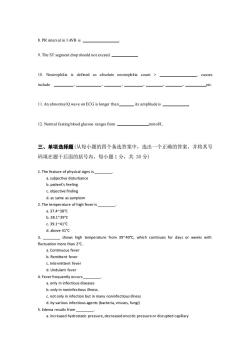
8.PR interval in IAVB is 9.The ST segment drop should not exceed 10.Neutrophilia is defined as absolute neutrophilia count> causes include etc 11.An abnormalQ wave on ECG is longer than. its amplitude is 12.Normal fasting blood glucose ranges from mmol/L 三、单项选择题(从每小题的四个备选答案中,选出一个正确的答案,并将其号 码填在题干后面的括号内,每小题1分,共30分) 1.The feature of physical signs is a.subiective disturbance b.patient's feeling c.objective finding d.as same as symptom 2.The temperature of high fever is a.37.4~38℃ b.38.1~39C c.39.141℃ d.above 41C 3. shows high temperature from 39~40C,which continues for days or weeks with fluctuation more than 2C a.Continuous fever b.Remittent fever c.Intermittent feve d.Undulant feve 4.Fever frequently occurs a.only in infectious diseases c.notonyininfectonbutinmanynoninfectioustlnes d.by various infectious agents(bacteria,viruses,fungi) 5.Edema results from_ a.increased hydrostatic pressure,decreased oncotic pressure or disrupted capillary
8. PR interval in I AVB is . 9. The ST segment drop should not exceed . 10. Neutrophilia is defined as absolute neutrophilia count > , causes include 、 、 、 、 、 、 etc. 11. An abnormal Q wave on ECG is longer than , its amplitude is . 12. Normal fasting blood glucose ranges from mmol/L. 三、单项选择题(从每小题的四个备选答案中,选出一个正确的答案,并将其号 码填在题干后面的括号内,每小题 1 分,共 30 分) 1. The feature of physical signs is _. a. subjective disturbance b. patient's feeling c. objective finding d. as same as symptom 2. The temperature of high fever is _. a. 37.4~38°C b. 38.1~39°C c. 39.1~41°C d. above 41°C 3. _ shows high temperature from 39~40°C, which continues for days or weeks with fluctuation more than 2°C. a. Continuous fever b. Remittent fever c. Intermittent fever d. Undulant fever 4. Fever frequently occurs _. a. only in infectious diseases b. only in noninfectious illness. c. not only in infection but in many noninfectious illness d. by various infectious agents (bacteria, viruses, fungi) 5. Edema results from _. a. increased hydrostatic pressure, decreased oncotic pressure or disrupted capillary
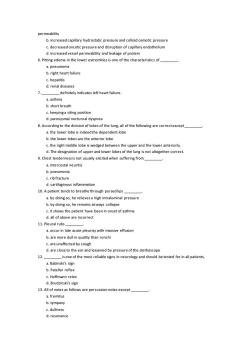
permeability c.decreased oncotic pressure and disruption of capillary endothelium d.increased vessel permeability and leakage of protein 6.Pitting edema in the lower extremities is one of the characteristics of_ a.pneumonia b.right heart failure c.hepatitis d.renal diseases definitely indicates left heart failure a.asthma b.short breath 8.According to the division of lobes of the lung,all of the following are correctexcept a.the lower lobe is indeed the dependent lobe b.the lower lobes are the anterior lobe upperand ignation of uppe fthe lung is not altogether correc 9.Chest tenderness is not usually elicited when suffering from a.intercostal neuritis b.pneumonia c.rib fracture d.cartlagi ous inflammation 10.Apatient tendsto breathe through pursedlips a.by doing so,he relievesa high intraluminal pressure b.by doing so,he remains airways collapse c.it shows the patient have been in onset of asthma d.all of above are 11.Pleuralrubs a.occur in late acute pleurisy with massive effusion b.are more dull in quality than ronchi c.are unaffected by cough d.the earand by pressure of the 12 be tested for in all patients a.Babinski's sign b.Patellar reflex c.Hoffmann relex d.Brudzinski's sign 13.All of notes as foll are pe ssion notes except a.fremitus b.tympany c.dullness d.resonance
permeability b. increased capillary hydrostatic pressure and colloid osmotic pressure c. decreased oncotic pressure and disruption of capillary endothelium d. increased vessel permeability and leakage of protein 6. Pitting edema in the lower extremities is one of the characteristics of _. a. pneumonia b. right heart failure c. hepatitis d. renal diseases 7. _ definitely indicates left heart failure. a. asthma b. short breath c. keeping a siting position d. paroxysmal nocturnal dyspnea 8. According to the division of lobes of the lung, all of the following are correct except _. a. the lower lobe is indeed the dependent lobe b. the lower lobes are the anterior lobe c. the right middle lobe is wedged between the upper and the lower anteriorly. d. The designation of upper and lower lobes of the lung is not altogether correct. 9. Chest tenderness is not usually elicited when suffering from _. a. intercostal neuritis b. pneumonia c. rib fracture d. cartilaginous inflammation 10. A patient tends to breathe through pursed lips _. a. by doing so, he relieves a high intraluminal pressure b. by doing so, he remains airways collapse c. it shows the patient have been in onset of asthma d. all of above are incorrect 11. Pleural rubs _. a. occur in late acute pleurisy with massive effusion b. are more dull in quality than ronchi c. are unaffected by cough d. are close to the ear and lessened by pressure of the stethoscope 12. _ is one of the most reliable signs in neurology and should be tested for in all patients. a. Babinski's sign b. Patellar reflex c. Hoffmann relex d. Brudzinski's sign 13. All of notes as follows are percussion notes except _. a. fremitus b. tympany c. dullness d. resonance
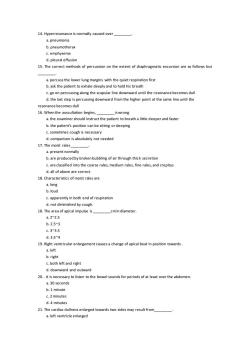
14.Hyperresonance is normally caused over_ a.pneumonia b.pneumothorax c.emphysema d.pleural effusion 15.The correct methods of percussion on the extent of diaphragmatic excursion are as follows but b.ask the patient to exhale deeply and to hold his breath c.go on percussing along the scapular line downward until the resonance becomes dull d.the last step is percussing downward from the higher point at the same line until the resonance becomes dull 16.When the auscultation begins b.the patient's position can be sitting or sleeping c.sometimes cough is necessary d.comparison is absolutely not needed 17.The moist rales ubroken bubbling ofaro c.are classified into the coarse rales,medium rales,fine rales,and crepitus d.all of above are correct 18.Characteristics of moist rales are a.long b.loud c.apparently in both end of respiration d.not diminished by cough. 18.The area of apical impulse is_ cmin diameter a.22.5 h25w3 c.335 d.3.54 19.Right ventricular enlargement causes a change of apical beat in position towards. a left c.both left and right d.downward and outward 20.It is necessary to listen to the bowel sounds for periods of at least over the abdomen. a.30 seconds b.1minute d.4 minutes 21.The cardiac dullness enlarged towards two sides may result from a.left ventricle enlarged
14. Hyperresonance is normally caused over _. a. pneumonia b. pneumothorax c. emphysema d. pleural effusion 15. The correct methods of percussion on the extent of diaphragmatic excursion are as follows but _. a. percuss the lower lung margins with the quiet respiration first b. ask the patient to exhale deeply and to hold his breath c. go on percussing along the scapular line downward until the resonance becomes dull d. the last step is percussing downward from the higher point at the same line until the resonance becomes dull 16. When the auscultation begins, _ is wrong. a. the examiner should instruct the patient to breath a little deeper and faster b. the patient's position can be sitting or sleeping c. sometimes cough is necessary d. comparison is absolutely not needed 17. The moist rales _. a. present normally b. are produced by broken bubbling of air through thick secretion c. are classified into the coarse rales, medium rales, fine rales, and crepitus d. all of above are correct 18. Characteristics of moist rales are a. long b. loud c. apparently in both end of respiration d. not diminished by cough. 18. The area of apical impulse is _cm in diameter. a. 2~2.5 b. 2.5~3 c. 3~3.5 d. 3.5~4 19. Right ventricular enlargement causes a change of apical beat in position towards . a. left b. right c. both left and right d. downward and outward 20. . It is necessary to listen to the bowel sounds for periods of at least over the abdomen. a. 30 seconds b. 1 minute c. 2 minutes d. 4 minutes 21. The cardiac dullness enlarged towards two sides may result from_ . a. left ventricle enlarged

b.right ventricle enlarged c.hydropericardium d.emphysema 22.The 2nd aortic area is located in a.the 5th left intercostal space.1 or 2 cm medial to the midclavicular line b.the 2nd left intercostal space just lateral to the sternum c.the 3rdor 4th left intercostal space lateral to the sternum d.he2ndrnghtniercosalspacejustlaieraltothesernum 23.Pulse a.tachycardia b.bradycardia c.trigeminal beats d.lti it is in old persons a.P2>A2 b.P2<A2 c P7=A2 d.no P2 a.Longer pause between 51 and 52 b.That $2 is clearly audible in the pulmonary valve area c.That $2 is higher in frequency and shorter in duration than S1 d.That be identified by synchronous palpation over radial arter 26.A loud S1 may be heard in a.mitral stenosis b.mitral regurgitation c.aortic stenosis d.aortic regurgitation a.damaged semilunar valve b.hypertensior c.hyperthyroidism d.pulmonary artery hypertension 8 isveryuseful in differentiaion between functional and organic murmurs a.The murur found b.Blowing or ejection in quality c.The murmur located in pulmonary valve area d.The signs of heart enlarged found 29.In hyperthyroidism.some special eve signs could be found.for example.the retraction of the is referedto a.Stellwag's sign b.Horner's syndrome c.Moebius's sign d.Ectropion
b. right ventricle enlarged c. hydropericardium d. emphysema 22. The 2nd aortic area is located in_ . a. the 5th left intercostal space, 1 or 2 cm medial to the midclavicular line b. the 2nd left intercostal space just lateral to the sternum c. the 3rd or 4th left intercostal space lateral to the sternum d. the 2nd right intercostal space just lateral to the sternum 23. Pulse deficit often occurs in_ . a. tachycardia b. bradycardia c. trigeminal beats d. atrial fibrillation 24. Normally, it is in old persons_. a. P2>A2 b. P2<A2 c. P2=A2 d. no P2 25. is most important in differentiation between S1 and S2_. a. Longer pause between S1 and S2 b. That S2 is clearly audible in the pulmonary valve area c. That S2 is higher in frequency and shorter in duration than S1 d. That S1 could be identified by synchronous palpation over radial artery 26. A loud S1 may be heard in_ . a. mitral stenosis b. mitral regurgitation c. aortic stenosis d. aortic regurgitation 27. Louder S2 in the 2nd right intercostal space just lateral to the sternum is heard with _. a. damaged semilunar valve b. hypertension c. hyperthyroidism d. pulmonary artery hypertension 28. _ is very useful in differentiation between functional and organic murmurs. a. The murmur found in children or young adults b. Blowing or ejection in quality c. The murmur located in pulmonary valve area d. The signs of heart enlarged found 29. In hyperthyroidism, some special eye signs could be found, for example, the retraction of the upper lids which is refered to _. a. Stellwag's sign b. Horner's syndrome c. Moebius's sign d. Ectropion
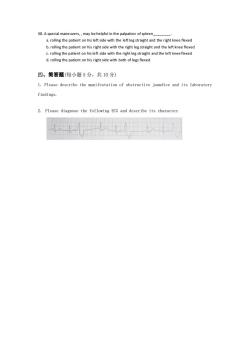
30.A special maneuvers,may be helpful in the palpation of spleen a.rolline the patient on his left side with the left lee straight and the right knee flexed c.patient on his left side with the right leg straightand the f kneeflexed d.rolling the patient on his right side with both of legs flexed 四、简答题(每小题5分,共10分) 1.Please describe the manifestation of obstructive jaundice and its laboratory findings. 2.Please diagnose the following ECG and describe its character
30. A special maneuvers, , may be helpful in the palpation of spleen_. a. rolling the patient on his left side with the left leg straight and the right knee flexed b. rolling the patient on his right side with the right leg straight and the left knee flexed c. rolling the patient on his left side with the right leg straight and the left knee flexed d. rolling the patient on his right side with both of legs flexed 四、简答题(每小题 5 分,共 10 分) 1. Please describe the manifestation of obstructive jaundice and its laboratory findings. 2. Please diagnose the following ECG and describe its character
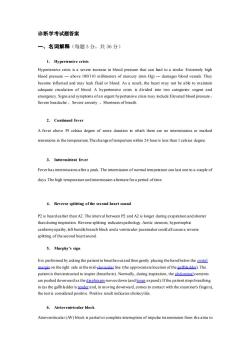
诊断学考试题答案 一、名词解释(每题3分,共36分) 1.Hypertensive crisis Hypertensive crisis is a severe increase in blood pressure that can lead to a stroke.Extremely high blood pressure-above 180/110 mllimeters of mercury (mm Hg)-damages blood vessels.They become inflamed and may leak fluid or blood.As a result,the heart may not be able to maintair adequate circulation of blood.A hypertensive erisis is divided into two categories:urgent and emergency.Signs and symptoms ofan urgent hypertensive crisis may include:Elevated blood pressure, Severe headache,Severe anxiety,Shortness of breath. 2.Continued fever A fever above39 celsius degree of some durationn which therere no marked remissions in the temperature.The change oftemperture within 24 houris less thanIcelsius degree. 3.Inttermittent fever days The high temperatureand intermission altemate fora period oftime. 4.Reverse splitting of the second heart sound P2 is heard earlier than A2.The interval between P2 and A2 is longer during exspirationand shorter than during inspiration.Reverse splitting indicatespathology.Aortic stenosis,hypertrophic cardiomyopathy,left bundke branch block and a pacemakercou all causea revers spliting of the second heart sound 5.Murphy's sign It is performed by asking the patientto breathe out and then gently placing the hand below the costal mainon the right side atthe mid-cavicline(the approximate location of the gaaddr).The patient is then instructed to inspire (breathe in).Normally.during inspiration.the abdominalcontents are pushed downward().Ifthe patient stopsbreathing drand,in moving d wnward,comes in contact with the examiner's fingers). the test is considered positive.Positive resu indicates cholecytitis 6.Atrioventricular block Atrioventricular(AV)block is partialor complete intemrupion of impulse transmission from the atria to
诊断学考试题答案 一、名词解释(每题 3 分,共 36 分) 1. Hypertensive crisis Hypertensive crisis is a severe increase in blood pressure that can lead to a stroke. Extremely high blood pressure — above 180/110 millimeters of mercury (mm Hg) — damages blood vessels. They become inflamed and may leak fluid or blood. As a result, the heart may not be able to maintain adequate circulation of blood. A hypertensive crisis is divided into two categories: urgent and emergency. Signs and symptoms of an urgent hypertensive crisis may include:Elevated blood pressure, Severe headache ,Severe anxiety ,Shortness of breath. 2. Continued fever A fever above 39 celsius degree of some duration in which there are no intermissions or marked remissions in the temperature.The change of temperture within 24 hour is less than 1 celsius degree. 3. Inttermittent fever Fever has intermissions after a peak. The intermission of normal temperature can last one to a couple of days. The high temperature and intermission alternate for a period of time. 4. Reverse splitting of the second heart sound P2 is heard earlier than A2. The interval between P2 and A2 is longer during exspiration and shorter than during inspiration. Reverse splitting indicates pathology. Aortic stenosis, hypertrophic cardiomyopathy, left bundle branch block and a ventricular pacemaker could all cause a reverse splitting of the second heart sound. 5. Murphy’s sign It is performed by asking the patient to breathe out and then gently placing the hand below the costal margin on the right side at the mid-clavicular line (the approximate location of the gallbladder). The patient is then instructed to inspire (breathe in). Normally, during inspiration, the abdominal contents are pushed downward as the diaphragm moves down (and lungs expand). If the patient stops breathing in (as the gallbladder is tender and, in moving downward, comes in contact with the examiner's fingers), the test is considered positive. Positive result indicates cholecytitis. 6. Atrioventricular block Atrioventricular (AV) block is partial or complete interruption of impulse transmission from th e atria to

the ventricles The most commcause is idopathic fibrosis and sclerosis of the conduction system Diagnosis is by ECG. 7.Premature ventricular conraction(PVC), PVC known asventricular premature beat(VPB)or extrasystole,is a fomm of irregular heartbeat in which theicontractsprematurely.This may be perceived asa"skipped beat"oraspaitatios The depolarization of cardiac myocytes begins in the ventricle instead of the usual place,the sinoatrial PVCs can be auseful naturalprobe ince they induce characteristc can be measured,and used to. 8.SAM phenomenon In some patients,the mitral valve moves forward and touchesthe spetum(there should normally be a considerable valveand spetum)during from the hear,thereby 9.Referred pain 10.Edema Edema means swelling caused by fluid in tissue of patients'body'.It usually occurs in the feet,ankles and legs,but ther entire body can be involved. 11.Diarrhea In medicine,diarhea refers to frequent loose or liquid bowel movements.Diarhea is most commonly caused by viral infections.parasitesor bacteraltoxins. 12.Gallop rhythm A gallop rhythm refers to a(usually abnormal)rhythm ofthe heart on a ascultation.The normal hear hythm Sand S2.giving the well-k rhythm.Gallo
the ventricles. The most common cause is idiopathic fibrosis and sclerosis of the conduction system. Diagnosis is by ECG. 7. Premature ventricular contraction (PVC), PVC known as ventricular premature beat (VPB) or extrasystole, is a form of irregular heartbeat in which the ventricle contracts prematurely. This may be perceived as a "skipped beat" or as palpitations. The depolarization of cardiac myocytes begins in the ventricle instead of the usual place, the sinoatrial node. PVCs can be a useful natural probe, since they induce Heart rate turbulence whose characteristics can be measured, and used to evaluate cardiac function. 8. SAM phenomenon In some patients, the mitral valve moves forward and touches the spetum (there should normally be a considerable gap between mitral va lve and spetum) during the ejection of blood from the heart, thereby partially blocking the flow of the blood from the outflow tract into the aorta. 9. Referred pain Referred pain is a phenomenon used to describe pain from internal organ and deep tissue dama ge can be perceived at a surface site, or cause hypersensitivity of pain. 10. Edema Edema means swelling caused by fluid in tissue of patients’ body'. It usually occurs in the feet, ankles and legs, but ther entire body can be involved. 11. Diarrhea In medicine, diarrhea refers to frequent loose or liquid bowel movements. Diarrhea is most commonly caused by viral infections, parasites or bacterialtoxins. 12. Gallop rhythm A gallop rhythm refers to a (usually abnormal) rhythm of the heart on auscultation. The normal heart rhythm contains two audible sounds, called S1 and S2, giving the well-known "lub-dub" rhythm. Gallop
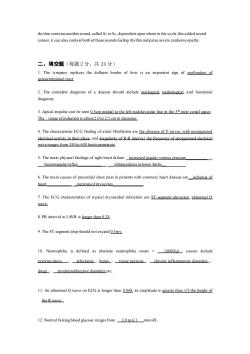
rhythm containsanother sound,called S;or Sa.dependent upon where in the cycle this added sound 二、填空题(每题2分,共24分) 1.The tympany replaces the dullness border of liver is an important sign of perforation of astricintestinal tract】 2.The compkte diagnosis of a disease should include tiological pathological and functional diagnosis. 3.Apical impulse can be seen5cm medal to the left midclaviculr line in the 5th inter costal space The ange ofpulsation is in diameter 4.The characteristic ECG finding of atrial fibrillation are the absence of P waves with unorganized electricalactivity in theirplace and imeaity of R-R interval the frequeny of unoreanized elctrical wave manges from 350to600 beatspeminute 5.The main physical findings of right hear falure ur venous press pittingedema in lower limbs 6.The main causes of precordial chest pain in patients with coronary heart disease areischem of heart necrosis of myocytes 7.The ECG characteristics of typical myocardial infarction areSTsem wave 8.PR interval in I AVB is longer than02S. 9.The ST segment dropshould not exceed 5my 10.Neutrophilia is defined as absolute neutrophilia count 10000/ulcauses include exerise.stres&_、_infections、hums、_tissuencsis、_chronic inflammatory disorders drugs mveloproliferative disorders etc 11.An abnommal Qwave on ECG is longer than 04 its amplitude is greater than 13 the height of the r wave 12.Nomal fasting blood glucose ranges mmol/L
rhythm contains another sound, called S3 or S4, dependent upon where in the cycle this added sound comes; it can also contain both of these sounds.Gallop rhythm indicates severe cardiomyopathy. 二、填空题(每题 2 分,共 24 分) 1. The tympany replaces the dullness border of liver is an important sign of perforation of gastricintestinal tract. 2. The complete diagnosis of a disease should include etiological, pathological, and functional diagnosis. 3. Apical impulse can be seen 0.5cm medial to the left midclavicular line in the 5th inter costal space. The range of pulsation is about 2.0 to 2.5 cm in diameter. 4. The characteristic ECG finding of atrial f ibrillation are the absence of P waves, with unorganized electrical activity in their place, and irregularity of R-R interval ,the frequency of unorganized electrical wave ranges from 350 to 600 beats perminute. 5. The main physical findings of right heart failure: _increased jagular venous pressure_, _hepatojagular reflex_, _pitting edema in lower limbs_. 6. The main causes of precordial chest pain in patients with coronary heart disease are_ischemia of heart _, _necrosis of myocytes_. 7. The ECG characteristics of typical myocardial infarction are ST segment elevation, abnormal Q wave. 8. PR interval in I AVB is longer than 0.2S. 9. The ST segment drop should not exceed 0.5mv. 10. Neutrophilia is defined as absolute neutrophilia count > 10000/ul , causes include exercise,stress 、 infections 、burns 、 tissue necrosis 、 chronic inflammatory disorders 、 drugs 、 myeloproliferative disorders etc. 11. An abnormal Q wave on ECG is longer than 0.04S, its amplitude is greater than 1/3 the height of the R wave. 12. Normal fasting blood glucose ranges from 3.9 to 6.1 mmol/L
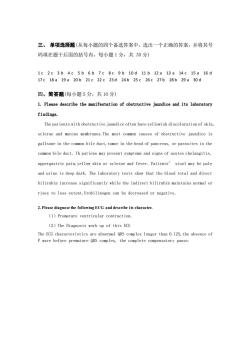
三、单项选择题(从每小题的四个备选答案中,选出一个正确的答案,并将其号 码填在题干后面的括号内,每小题1分,共30分) 1c 2c 3b 4c 5b 6b 7c 8c 9b 10d 11b 12a 13 a 14c 15a 16 d 17c18a19a20b21c22c23d24b25c26c27b28b29a30d 四、简答题(每小题5分,共10分) 1.Please describe the manifestation of obstructive jaundice and its laboratory findings. The patients with obstructive jaundice often have yellowish discoloration of skin, sclerae and mucous membranes.The most common causes of obstructive jaundice is gallsone in the common bile duct,tumor in the head of pancreas,or parasites in the common bile duct.Th patiens may present symptoms and signs of acutes cholangitis, uppergastric pain,yellow skin or sclerae and fever.Patients'stool may be pale and urine is deep dark.The laboratory tests show that the blood total and direct bilirubin increase significantly while the indirect bilirubin maintains normal or rises to less extent.Urobilinogen can be decreased or negative. 2.Please diagnose the following ECG and describe its character. (1)Premature ventricular contraction. (2)The Diagnosis work up of this ECG The ECG characteristics are abnormal QRS complex longer than 0.12S,the absence of P wave before premature QRS complex,the complete compensatory pause
三、 单项选择题(从每小题的四个备选答案中,选出一个正确的答案,并将其号 码填在题干后面的括号内,每小题 1 分,共 30 分) 1 c 2 c 3 b 4 c 5 b 6 b 7 c 8 c 9 b 10 d 11 b 12 a 13 a 14 c 15 a 16 d 17 c 18 a 19 a 20 b 21 c 22 c 23 d 24 b 25 c 26 c 27 b 28 b 29 a 30 d 四、简答题(每小题 5 分,共 10 分) 1. Please describe the manifestation of obstructive jaundice and its laboratory findings. The patients with obstructive jaundice often have yellowish discoloration of skin, sclerae and mucous membranes.The most common causes of obstructive jaundice is gallsone in the common bile duct,tumor in the head of pancreas, or parasites in the common bile duct. Th patiens may present symptoms and signs of acutes cholangitis, uppergastric pain,yellow skin or sclerae and fever. Patients’ stool may be pale and urine is deep dark. The laboratory tests show that the blood total and direct bilirubin increase significantly while the indirect bilirubin maintains normal or rises to less extent.Urobilinogen can be decreased or negative. 2. Please diagnose the following ECG and describe its character. (1)Premature ventricular contraction. (2)The Diagnosis work up of this ECG The ECG characteristics are abnormal QRS complex longer than 0.12S,the absence of P wave before premature QRS complex, the complete compensatory pause
按次数下载不扣除下载券;
注册用户24小时内重复下载只扣除一次;
顺序:VIP每日次数-->可用次数-->下载券;
- 《诊断学》课程教学实验指导.pdf
- 《诊断学》课程作业习题(英文,无答案).doc
- 《诊断学》课程作业习题(中文,部分含答案).doc
- 《诊断学》课程教学大纲(中英文双语).doc
- 重庆医科大学:《妇产科学》课程教学资源(PPT课件)29 计划生育.ppt
- 重庆医科大学:《妇产科学》课程教学资源(PPT课件)27 子宫内膜异位症.ppt
- 重庆医科大学:《妇产科学》课程教学资源(PPT课件)26 围绝经期综合征.ppt
- 重庆医科大学:《妇产科学》课程教学资源(PPT课件)25 闭经.ppt
- 重庆医科大学:《妇产科学》课程教学资源(PPT课件)24 功能失调性子宫出血.ppt
- 重庆医科大学:《妇产科学》课程教学资源(PPT课件)23 女性生殖器官损伤性疾病.ppt
- 重庆医科大学:《妇产科学》课程教学资源(PPT课件)22 妊娠滋养细胞疾病.ppt
- 重庆医科大学:《妇产科学》课程教学资源(PPT课件)21 卵巢肿瘤(ovarian tumor).ppt
- 重庆医科大学:《妇产科学》课程教学资源(PPT课件)20 子宫内膜癌.ppt
- 重庆医科大学:《妇产科学》课程教学资源(PPT课件)19 子宫肌瘤.ppt
- 重庆医科大学:《妇产科学》课程教学资源(PPT课件)17 女性生殖系统炎症.ppt
- 重庆医科大学:《妇产科学》课程教学资源(PPT课件)16 产后出血.ppt
- 重庆医科大学:《妇产科学》课程教学资源(PPT课件)15 胎儿窘迫.ppt
- 重庆医科大学:《妇产科学》课程教学资源(PPT课件)14 前置胎盘.ppt
- 重庆医科大学:《妇产科学》课程教学资源(PPT课件)12 妊娠合并急性病毒性肝炎.ppt
- 重庆医科大学:《妇产科学》课程教学资源(PPT课件)10 妊娠期肝内胆汁淤积症.ppt
- 石河子大学:《妇产科护理学》课程教学大纲 Nursing for Gynaecology and Obetetrics.pdf
- 石河子大学:《妇产科护理学》课程授课教案(负责人:张国琴).pdf
- 石河子大学:《妇产科护理学》课程教学课件(PPT讲稿)第十四章 月经失调病人的护理.ppt
- 石河子大学:《妇产科护理学》课程教学课件(PPT讲稿)第十六章 腹部手术病人的护理.ppt
- 石河子大学:《妇产科护理学》课程教学课件(PPT讲稿)第十三章 女性生殖系统炎症病人的护理.ppt
- 石河子大学:《妇产科护理学》课程教学课件(PPT讲稿)第十五章 妊娠滋养细胞疾病病人的护理.ppt
- 石河子大学:《妇产科护理学》课程教学课件(PPT讲稿)第九章 妊娠合并症妇女的护理.ppt
- 石河子大学:《妇产科护理学》课程教学课件(PPT讲稿)第十章 异常分娩妇女的护理.ppt
- 石河子大学:《妇产科护理学》课程教学课件(PPT讲稿)第十一章 分娩期并发症妇女的护理.ppt
- 石河子大学:《妇产科护理学》课程教学课件(PPT讲稿)第八章 妊娠期并发症妇女的护理.ppt
- 石河子大学:《妇产科护理学》课程教学课件(PPT讲稿)第五章 分娩期妇女的护理.ppt
- 石河子大学:《妇产科护理学》课程教学课件(PPT讲稿)第六章 产褥期管理.ppt
- 石河子大学:《妇产科护理学》课程教学课件(PPT讲稿)第一章 绪论 Obstetric and Gynecological Nursing.ppt
- 石河子大学:《妇产科护理学》课程教学课件(PPT讲稿)第二章 女性生殖系统解剖与生理.ppt
- 石河子大学:《妇产科护理学》课程教学课件(PPT讲稿)第四章 妊娠期妇女的护理.ppt
- 重庆医科大学:《实验诊断学》课程理论教学大纲(供五年制临床医学、儿科医学、预防医学、麻醉医学、影像医学专业本科使用).doc
- 重庆医科大学:《实验诊断学》课程实验教学大纲(供临床医学专业本科用).doc
- 重庆医科大学:《实验诊断学》课程教学资源(教案)第2讲 血液(下).doc
- 重庆医科大学:《实验诊断学》课程教学资源(教案)第6讲 肾功能.doc
- 重庆医科大学:《实验诊断学》课程教学资源(教案)第7讲 大便 免疫 心肌.doc
